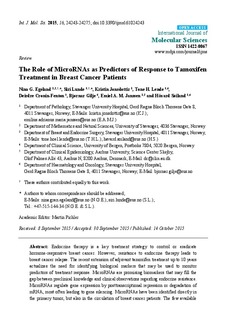| dc.contributor.author | Egeland, Nina | |
| dc.contributor.author | Lunde, Siri | |
| dc.contributor.author | Jonsdottir, Kristin | |
| dc.contributor.author | Lende, Tone Hoel | |
| dc.contributor.author | Cronin-Fenton, Deirdre P. | |
| dc.contributor.author | Gilje, Bjørnar | |
| dc.contributor.author | Janssen, Emilius Adrianus Maria | |
| dc.contributor.author | Søiland, Håvard | |
| dc.date.accessioned | 2016-04-07T13:53:42Z | |
| dc.date.accessioned | 2016-07-14T11:50:31Z | |
| dc.date.available | 2016-04-07T13:53:42Z | |
| dc.date.available | 2016-07-14T11:50:31Z | |
| dc.date.issued | 2015-10 | |
| dc.identifier.citation | Egeland, N. (et al.) (2015). The Role of MicroRNAs as Predictors of Response to Tamoxifen Treatment in Breast Cancer Patients. International Journal of Molecular Sciences 2015, 16(10):24243-24275 | |
| dc.identifier.issn | 1422-0067 | |
| dc.identifier.uri | http://hdl.handle.net/11250/2396535 | |
| dc.description | This is an open access article distributed under the Creative Commons Attribution License (CC BY) which permits unrestricted use, distribution, and reproduction in any medium, provided the original work is properly cited. | |
| dc.description.abstract | Endocrine therapy is a key treatment strategy to control or eradicate hormone-responsive breast cancer. However, resistance to endocrine therapy leads to breast cancer relapse. The recent extension of adjuvant tamoxifen treatment up to 10 years actualizes the need for identifying biological markers that may be used to monitor predictors of treatment response. MicroRNAs are promising biomarkers that may fill the gap between preclinical knowledge and clinical observations regarding endocrine resistance. MicroRNAs regulate gene expression by posttranscriptional repression or degradation of mRNA, most often leading to gene silencing. MicroRNAs have been identified directly in the primary tumor, but also in the circulation of breast cancer patients. The few available studies investigating microRNA in patients suggest that seven microRNAs (miR-10a, miR-26, miR-30c, miR-126a, miR-210, miR-342 and miR-519a) play a role in tamoxifen resistance. Ingenuity Pathway Analysis (IPA) reveals that these seven microRNAs interact more readily with estrogen receptor (ER)-independent pathways than ER-related signaling pathways. Some of these pathways are targetable (e.g., PIK3CA), suggesting that microRNAs as biomarkers of endocrine resistance may have clinical value. Validation of the role of these candidate microRNAs in large prospective studies is warranted. | |
| dc.description.abstract | | |
| dc.language.iso | eng | |
| dc.subject | kreft | |
| dc.subject | brystkreft | |
| dc.subject | microRNA | |
| dc.subject | endocrine resistance | |
| dc.title | The role of microRNAs as predictors of response to tamoxifen treatment in breast cancer patients | |
| dc.type | Journal article | |
| dc.type | Peer reviewed | |
| dc.date.updated | 2016-04-07T13:53:42Z | |
| dc.source.journal | International Journal of Molecular Sciences | |
| dc.identifier.doi | 10.3390/ijms161024243 | |
| dc.identifier.cristin | 1302293 | |
